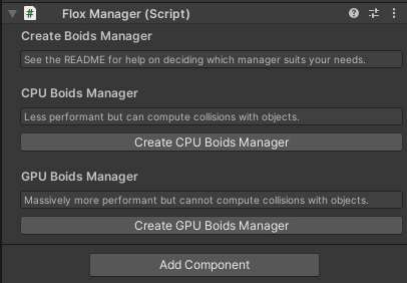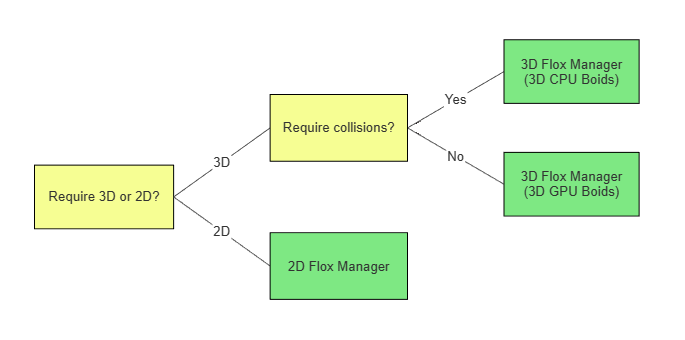Getting Started
Getting started with Flox is easy! The following steps show the install process:
First Time Use
Once you've imported the package into the scene, the only steps to perform are as follows:
- Select Tools > Flox > Create Flox Manager from Unity's toolbar.

- You should then be greeted in the inspector to a window with choices between a GPU and CPU boids manager.

Managers
You may be wondering which boid manager is right for you, and this section hopes to cover that.
Choosing a BoidManager
To save reading here's a quick decision tree on which BoidManager will suit your needs.

CPU or GPU BoidManager (detailed)
For the most part, a CPU boids manager should suffice. It computes the boids mostly on CPU threads within Unity, which is super easy to setup but suffers from decreased performance due to the crowding of the CPU threads with the boids algorithms.
A GPU boids manager foots the boids algorithm onto GPU threads in parrallel, which is just fancy talk for saying all the boids computations run at the same time, instead of one after the other - like on the CPU. This makes the boids algorithm pretty heckin' quick on the GPU, which means a lot more boids can be created into a scene with the GPU boids manager.
However, CPU boids have the added benefit of collisions detection on each boid, so that they can steer out the way of obstacles or other things. They are also physical objects within Unity, so can be collided with as well. This cannot happen on the GPU as the boids on there have no knowledge of physics or any obstacles. GPU boids include all of the other stuff that CPU boids have apart from that though, such as lighting support and specular mapping.
TL;DR
CPU boid manager if you want your boids to react to the environment/player characters but have less of them. GPU boid manager if you don't care and just want 10 times as many boids onscreen (not even kidding, it's that quick on the GPU).
Video
If you're struggling with getting Flox setup, there's a video on YouTube of myself running through the entire system, which can be found on YouTube.